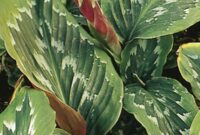I. Introduction
Braided hibiscus trees are known for their striking beauty and unique appearance, making them a popular choice for gardens and landscapes.
These trees, with their elegantly intertwined stems and vibrant blooms, can truly be a showstopper. However, to keep your braided hibiscus tree looking its best and ensure its continued health, proper pruning and shaping are essential.
In this guide, we’ll take you through the art of pruning and shaping braided hibiscus trees, step by step. Whether you’re a seasoned gardener or just starting out, understanding these techniques is crucial for maintaining the tree’s form and vitality.
The Importance of Proper Pruning
Pruning might seem daunting, but it’s a necessary aspect of caring for your braided hibiscus tree.
Properly pruned trees not only look more aesthetically pleasing but also enjoy improved air circulation, which can reduce the risk of disease and pests.
Pruning also encourages new growth and ensures that your tree remains a stunning focal point in your garden or landscape.
In the sections that follow, we’ll delve into the tools, techniques, and strategies for successful pruning and shaping of your braided hibiscus tree.
Whether you’re aiming for a specific shape or simply want to maintain its health and beauty, this guide has you covered. Let’s get started!
II. Pruning Tools and Safety
Before you embark on the journey of pruning and shaping your braided hibiscus tree, it’s essential to gather the right tools and prioritize safety.
Here, we’ll discuss the crucial tools you’ll need and emphasize the precautions to take before you start the pruning process.
Essential Pruning Tools
- Pruning Shears: Invest in a good pair of sharp pruning shears. These are your primary tools for making clean cuts on branches.
- Loppers: Loppers are ideal for cutting larger branches that pruning shears can’t handle. They provide extra leverage for cleaner cuts.
- Pruning Saw: For very thick branches, a pruning saw will be necessary. Choose one with a sharp blade designed for clean, efficient cuts.
- Gloves: Protect your hands with a pair of sturdy gardening gloves to avoid blisters and splinters.
- Safety Goggles: Wear safety goggles to shield your eyes from falling debris and small wood chips.
- Pruning Paint or Sealant: Pruning paint or sealant can help protect cut surfaces from disease and pests.
- Step Ladder: Depending on the height of your tree, you may need a step ladder to access higher branches safely.
Safety Precautions
- Protective Gear: Always wear appropriate protective gear, including gloves and safety goggles, to prevent injuries.
- Inspect Tools: Before you start, inspect your pruning tools to ensure they are in good working condition, sharp, and well-maintained.
- Weather Conditions: Avoid pruning during extreme weather conditions, such as strong winds or heavy rain, as it can be dangerous.
- Know Your Tree: Familiarize yourself with the specific needs of your braided hibiscus tree, as different trees may require different pruning techniques.
- Start Small: If you’re new to pruning, start with smaller branches and work your way up to larger ones as you gain confidence and experience.
- Cut at the Right Place: Learn where and how to make proper cuts to encourage healthy growth and minimize damage.
- Ask for Help: If the tree is particularly large or if you have concerns about your ability to safely prune it, consider seeking assistance from a professional arborist.
Taking the time to gather the necessary tools and following safety precautions will ensure that your pruning and shaping process is not only effective but also safe for you and your braided hibiscus tree.
With the right tools and safety measures in place, you’re ready to move on to the actual pruning techniques, which we’ll explore in the next section.
III. Pruning Techniques
Now that you’ve got your pruning tools ready and safety precautions in place, it’s time to dive into the actual pruning techniques for your braided hibiscus tree.
Below, we’ll outline specific techniques and provide step-by-step instructions along with valuable tips to help you make the most of each cut.
1. Deadheading:
Deadheading is the process of removing spent or faded flowers and seed pods. This encourages new blooms and maintains the tree’s appearance.
- Step 1: Examine your braided hibiscus tree for wilted or faded flowers and seed pods.
- Step 2: Using sharp pruning shears, locate the stem just above the first set of healthy leaves below the faded flower or seed pod.
- Step 3: Make a clean, angled cut just above this point, removing the entire faded flower or pod.
Tips: Deadhead your hibiscus tree regularly throughout the growing season to promote continuous blooming.
2. Thinning:
Thinning involves selectively removing branches to improve air circulation and reduce crowding.
- Step 1: Identify crowded or crossing branches that may be obstructing sunlight or airflow.
- Step 2: Use pruning shears or loppers to remove selected branches at their base, making clean cuts.
- Step 3: Focus on removing branches that are diseased, damaged, or weak.
Tips: Thinning helps prevent disease and allows for better light penetration, promoting healthier growth.
3. Heading Back:
Heading back is a technique used to control the size and shape of your tree.
- Step 1: Determine the branches you want to shorten or shape.
- Step 2: Locate a healthy bud or lateral branch that is facing the direction you want new growth to occur.
- Step 3: Make a diagonal cut just above the bud or lateral branch, ensuring a clean, sharp cut.
Tips: Heading back can be used to create a specific shape or control the size of your hibiscus tree.
4. Renewal Pruning:
Renewal pruning is a more aggressive technique used to rejuvenate older or overgrown hibiscus trees.
- Step 1: In late winter or early spring, cut the entire tree back to about one-third of its original height.
- Step 2: Remove any dead or weak branches completely.
- Step 3: Over the growing season, new shoots will emerge from the trimmed branches.
Tips: Renewal pruning should be done cautiously, as it may result in a year without blooms but will promote vigorous growth.
By mastering these pruning techniques and following the step-by-step instructions and tips provided, you’ll be well on your way to shaping and maintaining a healthy and beautiful braided hibiscus tree.
IV. Shaping Your Hibiscus Tree
Shaping your braided hibiscus tree is where the true artistry of gardening comes into play. The unique form of braided hibiscus trees can be accentuated or modified to your liking, enhancing their elegance and making them stand out in your garden or landscape.
In this section, we’ll explore the art of shaping these trees and provide guidance on creating specific shapes, such as a standard or a spiral.
Understanding the Art of Shaping
Shaping a braided hibiscus tree involves training it to grow in a particular direction or pattern while maintaining its overall health and vitality. The goal is to accentuate its natural beauty and create a visually appealing structure.
Creating a Standard Shape:
Standard-shaped braided hibiscus trees have a single, upright stem with a rounded canopy. This classic shape is a timeless choice for an elegant garden centerpiece.
- Step 1: Identify the main stem of your braided hibiscus tree.
- Step 2: Prune away any branches that deviate from the central stem, focusing on maintaining a single, upright trunk.
- Step 3: As the tree grows, periodically remove any new shoots that compete with the central stem.
Tips: Regularly prune and shape your tree to maintain its standard form. Use stakes or ties to support the central stem if needed.
Creating a Spiral Shape:
Spiral-shaped braided hibiscus trees have a unique, twisting trunk that adds a touch of whimsy to your garden.
- Step 1: Identify the central stem of your braided hibiscus tree.
- Step 2: As the tree grows, gently twist the stem in the desired direction.
- Step 3: Secure the twisted stem with soft plant ties or twine at regular intervals to maintain the spiral shape.
Tips: Spiral shaping requires patience and periodic adjustments to guide the tree’s growth in the desired spiral pattern.
Other Creative Shapes:
Feel free to let your creativity shine when shaping your braided hibiscus tree. Whether you prefer a heart shape, an S-curve, or any other unique design, the key is to prune and train the tree accordingly.
Keep in mind that more complex shapes may require greater care and maintenance. Remember that shaping your hibiscus tree is an ongoing process. Regular monitoring and pruning will be necessary to maintain the desired form.
Additionally, avoid excessive pruning, as it can stress the tree. The art of shaping hibiscus trees allows you to express your individual style and create a stunning focal point in your garden or landscape.
V. Maintenance and Aftercare
Pruning and shaping your braided hibiscus tree is a significant step towards achieving a beautiful and healthy garden centerpiece. However, the work doesn’t end with the final cut.
To ensure your tree continues to thrive and maintains its elegant form, it’s crucial to follow through with proper maintenance and aftercare.
Post-Pruning Care:
After you’ve completed the pruning and shaping process, your braided hibiscus tree needs some post-pruning care to aid its recovery and promote healthy growth.
- Watering: Ensure the tree receives adequate water, especially during dry spells. Deep watering is preferable to encourage the roots to grow deeper into the soil.
- Fertilizing: Apply a balanced, slow-release fertilizer to provide essential nutrients for the tree. Follow recommended guidelines for timing and dosage.
- Mulching: Apply a layer of mulch around the base of the tree to retain moisture, regulate soil temperature, and prevent weed growth.
- Protection from Pests and Disease: Keep an eye out for signs of pests or diseases. Early detection and treatment are essential to prevent damage.
- Sunlight: Make sure your tree receives the right amount of sunlight according to its specific requirements. Ensure it’s not overcrowded by other plants that may block sunlight.
Monitoring Tree Health:
To maintain your braided hibiscus tree’s health and shape, regular monitoring is key. Here’s what to look out for:
- New Growth: Observe the emergence of new shoots and branches. You may need to prune selectively to maintain the desired shape.
- Leaf Health: Monitor the condition of the leaves. Yellowing or browning leaves may indicate nutrient deficiencies or stress.
- Pest and Disease Signs: Keep an eye out for any signs of pests or diseases, such as discolored or damaged leaves, sooty mold, or unusual spots.
- Structural Integrity: Check the tree’s overall structure and shape. Ensure it remains balanced and doesn’t lean excessively.
- Watering Needs: Adjust your watering schedule according to weather conditions. Too much or too little water can stress the tree.
Future Pruning Schedules:
Pruning isn’t a one-time task; it’s an ongoing process to maintain the health and appearance of your braided hibiscus tree. Consider the following tips for future pruning schedules:
- Regular Maintenance: Schedule regular maintenance pruning sessions to remove dead or damaged branches, promote airflow, and shape the tree as needed.
- Seasonal Pruning: Prune your tree during the appropriate season. Late winter or early spring is often the best time for most pruning tasks.
- Rejuvenation Pruning: If you have an older tree, plan for periodic rejuvenation pruning to encourage new growth and maintain vitality.
- Consultation: If you’re uncertain about pruning needs or techniques, don’t hesitate to consult with a professional arborist for guidance.
By following these maintenance and aftercare practices, as well as staying vigilant in monitoring your braided hibiscus tree’s health, you’ll ensure that it continues to flourish and remains a stunning addition to your garden or landscape.
Proper care and maintenance will help you enjoy the beauty of your tree for years to come.


